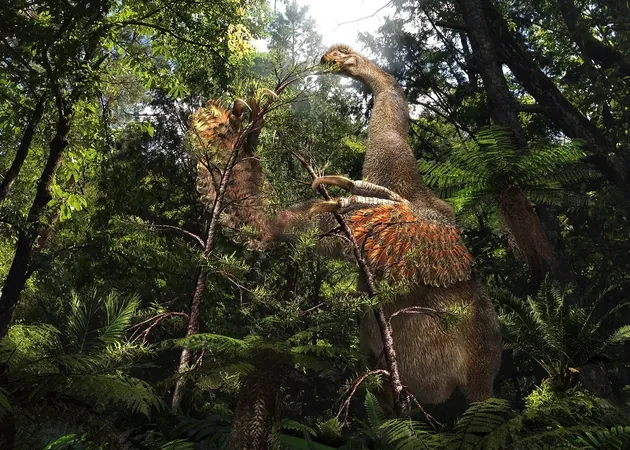
Unveiling Duonychus tsogtbaatari: Mongolia's Newly Discovered Two-Clawed Dinosaur!
2025-03-27
Author: Jacques
Introduction
A remarkable new species of dinosaur has recently been identified from the sandy expanses of Mongolia, shedding new light on the diversity and weirdness of the prehistoric world. Researchers have named this unique dinosaur Duonychus tsogtbaatari, which translates to ‘Tsogtbaatar’s two-claw,’ in honor of the famed palaeontologist Khishigjav Tsogtbaatar from the Mongolian Academy of Sciences. This extraordinary creature roamed the Earth between 96 to 90 million years ago during the Upper Cretaceous period, specifically from the Bayanshiree Formation in Mongolia’s iconic Gobi Desert.
Fossil Evidence and Characteristics
The fossil evidence of Duonychus presents an incomplete yet impressive array of bones, including forelimbs, hips, sections of the shoulder girdle, vertebrae, and remnants of the tail base. It belongs to the therizinosaur subgroup, which primarily thrived in Asia during the Cretaceous era. These dinosaurs are known for their striking features, including bipedal stature, elongated necks, and short tails, paired with their distinctive wide hips and clawed, feathered forelimbs.
Size and Skull Speculation
The newly discovered species is classed as mid-sized among therizinosaurs, weighing in at approximately 260 kg (or around 575 lbs) and measuring about 3 meters (10 feet) in length. While its skull is currently unknown, it is hypothesized to resemble other therizinosaurs, featuring a long and narrow shape complemented by small, leaf-like teeth that would have facilitated a herbivorous diet.
Unique Forelimb Structure
However, the standout characteristic of Duonychus is its peculiar forelimb structure; it possesses only two functional fingers, with a significantly reduced third finger, represented only by a minimized metacarpal bone. This unorthodox trait aligns Duonychus with other unique theropods like Tyrannosaurus rex and oviraptors, both of which feature two-fingered species as well.
Evolution of Finger Structure
The question arises: why would a dinosaur evolve to have fewer fingers? While it's often considered that diminishing fingers may stem from their decreasing utility over time, another theory suggests that the first two fingers might have undergone enlargement for specialized tasks, rendering the third finger unnecessary.
Curved Claws and Feeding Adaptations
Particularly fascinating are the claws of Duonychus, which exhibit extreme curvature. The researchers, led by Yoshitsugu Kobayashi, speculated these claws were likely adapted for grasping onto foliage, allowing the dinosaur to pull vegetation closer for feeding. Remarkably, the claw retains its keratin covering, indicating that in a living Duonychus, the claw would have been 40% longer and significantly more curved than the bony structure alone suggests.
Coexistence with Other Therizinosaurs
Notably, Duonychus coexisted with three other identified therizinosaurs in a diverse fauna that evidently engaged in different feeding habits, which may have minimized competition among the species.
Conclusion
This discovery not only enriches our understanding of therizinosaurs but also highlights the rich paleontological bounty still hidden beneath the surface of Mongolia's Gobi Desert. Researchers continue to unravel the mysteries of these incredible creatures, offering a remarkable glimpse into the era of giants that once roamed our planet.
Stay tuned for more exciting paleontological revelations from around the globe as scientists delve deeper into the past and uncover nature’s ancient marvels!









 Brasil (PT)
Brasil (PT)
 Canada (EN)
Canada (EN)
 Chile (ES)
Chile (ES)
 Česko (CS)
Česko (CS)
 대한민국 (KO)
대한민국 (KO)
 España (ES)
España (ES)
 France (FR)
France (FR)
 Hong Kong (EN)
Hong Kong (EN)
 Italia (IT)
Italia (IT)
 日本 (JA)
日本 (JA)
 Magyarország (HU)
Magyarország (HU)
 Norge (NO)
Norge (NO)
 Polska (PL)
Polska (PL)
 Schweiz (DE)
Schweiz (DE)
 Singapore (EN)
Singapore (EN)
 Sverige (SV)
Sverige (SV)
 Suomi (FI)
Suomi (FI)
 Türkiye (TR)
Türkiye (TR)
 الإمارات العربية المتحدة (AR)
الإمارات العربية المتحدة (AR)